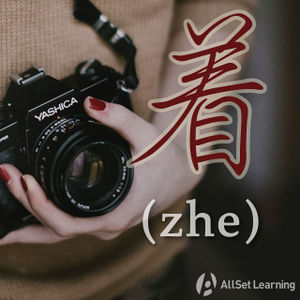Aspect particle "zhe"
-
Level
-
Similar to
-
Used for
-
Keywords
The particle 着 (zhe) is one way of indicating the continuous aspect in Mandarin Chinese (another common way is using the adverb 在 in front of verbs). You may have heard that the Chinese particle 着 added onto the end of verbs is similar to the use of -ing in English. This isn't particularly helpful, however, because the use of 着 in Chinese is not nearly so frequent, and can also be quite idiomatic.
Contents
Basic Usage
Structure
Verb + 着
Examples
- 我 读 ,你 听 着 。I'll read, and you will listen.
- 我们 做 ,你们 看 着 。We will do it, and you will watch.
- 你们 坐 着 ,我 马上 回来 。Sit here. I'll be right back.
- 我 出去 一下 ,你 帮 我 看 着 行李 。I'll go out for a second, and you watch the luggage for me.
Used for Manner or State in which an Action is Performed
Structure
Verb 1 + 着 + Verb 2
Note that the first verb (followed by 着) describes the state; the second verb is the action verb. In this case, the "-ing" translation can be useful.
Examples
- 她 喜欢 站 着 吃饭 。"standing + eat = eating while standing"
- 他 笑 着 说 “对不起” 。"smiling + say = saying "I'm sorry" while smiling
- 孩子 抱 着 爸爸 哭 了 起来 。"hugging + cry = crying while hugging
Note: If you want to make a sentence where both verbs are action verbs (neither is truly a state), then you don't want this pattern, you want 一边⋯⋯,一边⋯⋯.
Used for Continuous State
While it's true that the "full progressive pattern" can make use of 着, this is not a pattern you're going to want to use all the time. The most commonly used verbs are the ones below:
- 开 (kāi) alone can mean "to open" or "to turn on." Adding 着 allows one to express that something "is open" or "is on."
- 关 (guān) alone can mean "to close" or "to turn off." Adding 着 allows one to express that something "is closed" or "is off."
- 穿 (chuān) alone means "to wear." Adding 着 allows one to express that one "is wearing" or "has" something (on one's person).
- 戴 (dài) alone means "to wear." Adding 着 allows one to express that one "is wearing" or "has" something (on one's person).
- 躺 (tǎng) alone means "to lie on one's back." Adding 着 allows one to express that someone "is lying down."
Examples
- 公司 的 门 开 着 ,可是 没 人 在 。"Being on" is a state, so using 着 is natural.)The company's door is open but no one is in there.
- 公司 的 门 在 开 ,可是 没 人 在 。"Being open" is not an action, so don't use 在.)
- 她 穿 着 一 条 小 黑 裙 。"Be wearing" is a state, so using 着 is natural.)She's wearing a little black dress.
- 她 在 穿 一 条 小 黑 裙 。"Be wearing" is not an action, so don't use 在.)
- 躺 着 最 舒服 。"Lying here" is a state, so using 着 is natural.)It makes me most comfortable just lying there.
- 在 躺 最 舒服 。"Lying here" is not strictly an action, so don't use 在.)
Colloquial Saying
Certain verbs tend to take 着 more frequently than others, and exactly what the 着 is doing might not be apparent at all. It's best to think of these usages as colloquialisms. You can even think of them as set phrases.
Examples of this usage:
- 听 着 ! "to listen and keep listening"
- 别 客气 ,拿 着 吧 。"to take and keep it"
- 你们 等 着 ! "to wait and keeping waiting"
There's also one colloquial usage of 着 that's been chosen by at least one textbook for special treatment, so we'll cover it here as well:
Subj. + 是 + Verb + 着 + 玩 + 的
This pattern may look like that "doing an action in a particular state" pattern already covered above, but in practice it doesn't really work that way. It just means "[Verb] for fun" or "[Verb] as a joke."
Examples of this usage:
- 你 不要 生气 ,我 是 说 着 玩 的 。Don't be mad. I was just joking.
- 我 听不懂 英文 歌 ,只 是 听 着 玩 的 。I don't understand English songs. I listen just for fun.
See also
Sources and further reading
Books
- A Practical Chinese Grammar For Foreigners (外国人实用汉语语法) (pp. 414 - 423) Anything Goes (无所不谈) →buy
- Chinese: An Essential Grammar, Second Edition (pp. 89) Anything Goes (无所不谈) →buy
- Mandarin Chinese: A Functional Reference Grammar (pp. 217 - 225) Anything Goes (无所不谈) →buy
- Integrated Chinese: Level 1, Part 2 (3rd ed) (pp. 242-3) Anything Goes (无所不谈) →buy
- Integrated Chinese: Level 2, Part 2 (pp. 17) Anything Goes (无所不谈) →buy
- New Practical Chinese Reader 2 (新实用汉语课本2) (pp. 238-9) Anything Goes (无所不谈) →buy
- 40 Lessons for Basic Chinese Course (基础汉语40课上册) (pp. 255) [ →buy]
Websites
- About.com: Mandarin Chinese Aspect
- ChinesePod: Qing Wen - The 着 (zhe) Chronicles: How We Verb (free content)
- ChinesePod: Qing Wen - The 着 (zhe) Chronicles: Actions in Progress (free content)
- ChinesePod: Qing Wen - The 着 (zhe) Chronicles: Verbs as States (free content)



